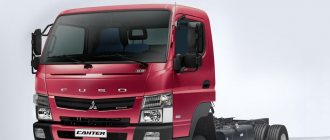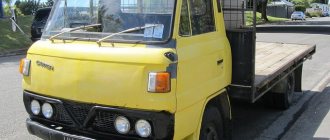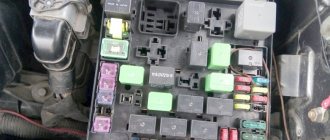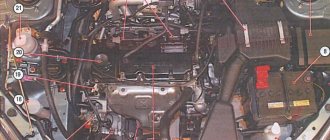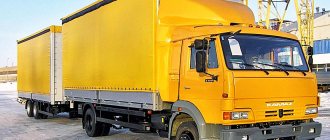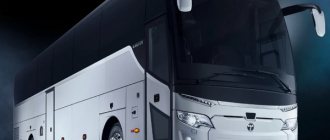In total, about three thousand Fuso Canter cars have been sold by dealers since the launch of the model in Naberezhnye Chelny (Tatarstan). In addition to a very reasonable price - about one and a half million rubles for a chassis with a manufactured goods van - the Japanese is also attracted by its reputation as a very reliable car. This has long been tested in practice - since the early 1990s, more than thirty thousand used right-hand drive cars of this model have been imported to Russia from Japan. And, as a rule, the owners who wrote reviews on the Internet are satisfied with the purchase. According to the analytical agency "Autostat" (see table), the majority of registered vehicles are 15-23 year old right-hand drive Mitsubishi Canters. Yes, that’s exactly what, in a nutshell, the car is called in the domestic market. The Japanese began to intensively promote the Fuso brand, known since 1932, only in 2007. Since then, apparently guided by the results of some very complex marketing research, the company has been promoting the same car either under the Mitsubishi Fuso brand - in Russia, Belarus, the Baltic countries, Turkey, USA, Canada, etc. - or simply Fuso , as in most countries of Europe, Mexico, Australia, etc. Silencing or advertising the generic name of a company is purely individual for the market of a particular country - for example, buyers from Slovakia are impressed by the fact that Canter is a Mitsubishi, and their Czech neighbors are impressed by some reasons it is not necessary to know this. Or even undesirable.
Historical reference
In Russia, Canter is found with documents from three different brands: Mitsubishi - the vast majority of them, Fuso - a small second-hand car from Germany, and Mitsubishi Fuso - from a gradually growing fleet of cars assembled in Russia. The distribution among federal districts is also characteristic—almost 13 times the predominance of the Far East over the center. And a gradual decline in the direction from Primorye to the west - to a meager three to four hundred left-hand drive units for the entire Northwestern Federal District, including St. Petersburg with a population of 5 million. However, the overwhelming majority of right-hand drive trucks with three diamonds on the radiator grill belong not to carriers, but to small entrepreneurs or even just economical villagers and summer residents. More often these are versions with a gross weight of up to 3.5 tons - in order to drive with category B, and customs took less from light trucks. And structurally, the Canter from the Japanese market is not too similar to its Russian-assembled counterpart. The right-hand drive engine usually has mechanical fuel injection instead of the modern Common Rail system, the front suspension is often spring or torsion bar, and the rear wheels are of a smaller diameter (for example, 14-inch versus 15-inch front). And in general, those who bought a right-hand drive Canter for 200–300 thousand rubles, in fact, live in another Russia - not the one where the Chelny Fuso for one and a half million rubles is considered “attractively priced.” Nevertheless, the experience that they share with each other on forums on the Internet can also be useful for large vehicle fleets with a dozen or more brand-new KAMAZ-assembled Fuziks. Why, for example, pay 50 thousand rubles to an official dealer for a Japanese spring if a Korean one from Hyundai Mighty is suitable? For only seven thousand... And there can be dozens of such alternative replacement positions.
Characteristics of Mitsubishi Canter
Below are the technical characteristics of the Mitsubishi Canter in expanded form.
Characteristics of Mitsubishi Canter 4.9 l.
| Body type | Commercial |
| Length, mm | 5975 |
| Width, mm | 2135 |
| Height, mm | 2235 |
| Ground clearance, mm | 200 |
| Front track, mm | 1665 |
| Rear track, mm | 1660 |
| Wheelbase, mm | 3410 |
| Turning diameter, m | 12.2 |
| Curb weight, kg | 2755 |
| Total weight, kg | 8500 |
| Trunk volume, l | — |
| Number of doors | 2 |
| Number of seats | 3 |
| Drive unit | Rear |
| engine's type | Diesel turbocharged |
| Number of cylinders / arrangement | 4/Inline |
| Engine power, hp/rpm | 180/2700 |
| Engine displacement, cm³ | 4899 |
| Torque, Nm/rpm | 530/1600 |
| Type of fuel | DT |
| Fuel tank volume, l | 100 |
| Acceleration time to 100 km/h, sec | — |
| Maximum speed, km/h | 108 |
| Fuel consumption in the urban cycle, l per 100 km | — |
| Fuel consumption on the highway, l per 100 km | — |
| Fuel consumption in the combined cycle, l per 100 km | 19.0 |
| Gearbox type | Mechanical, 6 gears |
| Power steering | Power steering |
| Front suspension | Dependent, spring |
| Rear suspension | Dependent, spring |
| Front brakes | Drums |
| Rear brakes | Drums |
| Electronic control systems | ABS |
| Climate control | Air conditioner |
| Tire size | 215/75 R17 |
| Trailer weight without brakes / with brakes, kg | -/3500 |
Specifications
Dimensions depending on version (E/G/H/J):
- length – 5975/6655/7130/7565 mm;
- width (for all versions) – 2135 mm;
- height (for all versions) – 2235 mm;
- wheelbase – 3410/3870/4170/4470 mm;
- front track (for all versions) – 1665 mm;
- rear track (for all versions) – 1660 mm;
- ground clearance (for all versions) – 200 mm;
- frame width (for all versions) – 840 mm;
- front overhang (for all versions) – 1145 mm;
- rear overhang – 1420/1640/1815/1950 mm;
- minimum turning radius – 6100/6900/7300/78000 mm.
The total weight of the Mitsubishi Fuso Canter is 8500 kg. The car is capable of climbing with a maximum slope of up to 43.3 degrees. The maximum speed is 123 km/h.
Engine
A special feature of the Mitsubishi Fuso Canter series is that all modifications are equipped with self-produced units of increased reliability. The latest versions are equipped with a 4-cylinder diesel engine Mitsubishi 4M50-5AT5. The optimal level of torque is ensured by the operation of the intercooler, injection mechanism, camshaft and turbocharger. To minimize vibration, 2 equalizer shafts are used (especially effective when driving at above average speeds). The engine fully complies with Euro-4 environmental requirements. Other features include:
- water cooling;
- Common Rail direct fuel injection;
- glow plug.
Mitsubishi 4M50-5AT5 engine characteristics:
- working volume – 4.899 l;
- rated power – 132 (180) kW (hp);
- maximum torque 530 Nm.
Average fuel consumption is 21 l/100 km. The fuel tank holds 100 liters.
Fuel consumption
On average, the fuel consumption of the Mitsubishi Fuso Canter is 21 liters per 100 km. This is ensured by installing an engine with an internal combustible mixture formation system.
Fuel tank
checkpoint
The Mitsubishi Fuso Canter is equipped with a gearbox with 6 forward and 1 reverse gears. The first speed and reverse gears are constant mesh, and the remaining gears are synchronized.
Chassis
The Fuso Canter chassis is high-tech and functional, it ensures operator safety through the RISE system. The latter includes:
- front beams of the supporting structure, deformation of which occurs in the longitudinal direction during a frontal collision;
- reinforced cabin block;
- door beams that protect in side collisions.
Rear wheel
The supporting frame includes stiffening ribs, thanks to which the machine is able to withstand heavy loads and any superstructure. The basis for creating the suspension was the Fighter model with a high load capacity.
Brake system
The Mitsubishi Fuso Canter truck is equipped with an ABS system, which increases braking efficiency. In the event of an emergency reduction in speed on icy or wet asphalt, the wheels do not lock, which makes the vehicle stable and controllable.
The exhaust brake is designed to improve the quality of braking and increase the service life of the system. It is part of the basic assembly of the machine.
History of Mitsubishi Canter
Since 1963, the truck has already gained great popularity in many countries and is sold in:
- Europe;
- Australia;
- Indonesia;
- USA;
- Asian countries;
- Japan;
Mitsubishi Canter is produced by a subsidiary of Mitsubishi Fuso. Therefore, you can often hear Canter being called Mitsubishi Fuso Canter.
The model was first released in March 1963. The first trucks were sold in Asian countries and in Japan itself. Since 1970, the car began to be sold in Europe, the Middle East and North America.
The car is available to Russian buyers in many versions. In addition to classic flatbed vans, cars can also be found in the following versions:
- Loader;
- Dump truck;
- Garbage truck;
- Auto hydraulic lift;
- Tow truck;
The Mitsubishi Canter has a spacious cabin with a sleeping area that can be created by folding down the seat backs. This allows the truck to be used for long hauls. It is worth noting that the cabin has a fairly low noise level. This was achieved through the use of high-tech engineering solutions. The interior upholstery uses light gray plastic and fabric.
In Russia, the Mitsubishi Canter is offered with a powerful 4.9-liter diesel engine. Despite its great performance, the engine is very economical. In the combined cycle, the fuel consumption of the Mitsubishi Canter is 19 liters per 100 km.
The car has a dependent leaf spring suspension at the front and rear. On the Russian market, the truck occupies a leading position in the field of light commercial vehicles. The machine is easy to maintain and reliable.
Device
The design of the Mitsubishi Fuso Canter is distinguished by the presence of the RISE system, which increases the safety of the driver and passengers. It includes:
- door beams that protect in the event of side collisions;
- front beams that deform in the longitudinal direction during a frontal collision;
- reinforcements for the cabin block.
The load-bearing frame also has special stiffening ribs that allow it to withstand the superstructure and heavy loads. The chassis of the Fuso Canter was built on the basis of the Fuso Fighter model with a higher load capacity.
The design of vans, chassis, flatbed vehicles and other versions of the series is practically the same. They are based on a frame staircase structure. The front and rear suspensions are dependent with leaf springs, anti-roll bar and double-acting telescopic shock absorbers that dampen vibrations. The front uses single-ply tires measuring 215/75R17.5, and the rear uses dual-ply tires measuring 215/75R17.5.
All versions of the Mitsubishi Fuso Canter use a transmission that includes a manual gearbox (6 forward speeds, 1 reverse speed) and a dry-type single-plate clutch with a diaphragm pressure spring and hydraulic drive. The reverse and first gear gears have constant mesh, the rest are synchronized.
The car uses a combined braking system, including:
- service brake – 2-circuit with drum elements and anti-lock system. On some modifications, discs are installed in front;
- parking brake - a system with expanding shoes in the drum;
- The mountain brake is a vacuum element with a throttle valve.
The car is equipped with a cabin with a unique architecture and halogen headlights, adding to its attractiveness. The large windshield and cleverly positioned mirrors provide excellent visibility in all directions. The cabin is equipped with a step to facilitate entry into the cabin. While driving, it is completely closed by the door to prevent snow and dirt from entering. Due to the high opening, you can get into the cabin without bending over. The driver's seat is very comfortable and has individual settings for maximum comfort. The reach is 192 mm, the back angle can be adjusted from 8 degrees forward to 30 degrees back.
The interior of the Mitsubishi Fuso Canter is quite boring, since the design is “stuck” somewhere in the 1990s. The priority here is comfort and practicality. The gearshift lever is located on the dashboard, not by the seats, which is very convenient. The steering wheel, lumbar support and backrest are adjustable. The passenger seat has 2 glove compartments, one of which is locked with a key. A special niche in A4 format allows you to carry a package of documents with you. The steering has a hydraulic booster.
New optics help you move safely in the dark. The bumper is made of durable synthetic material and has an anti-corrosion coating.
For maintenance or repairs, the vehicle's cab can be easily tilted using the control lever located at the rear of the passenger door. Refilling washer and brake fluid is done from the cab.
Driver's cabin
The equipment is equipped with a cabin with a unique design. It is comfortable and ergonomic, the position of the mirrors is carefully thought out, and the halogen headlights add to its attractiveness. The cabin width is almost 2 m, so the superstructure of wide vans will not become a safety hazard or obstruct visibility.
Steering wheel
The cabin of the Mitsubishi Fuso Canter is equipped with a step, which makes it easier to enter and exit the cabin. When moving, it closes with a door, which prevents dirt and snow from sticking. The door opens at an angle of up to 90 degrees. The high opening and high height of the cabin itself allow you to enter the cabin without bending over.
Canter Salon
The driver's seat is ergonomic and comfortable, and can be adjusted to suit individual needs. This guarantees reduced fatigue on long flights. The backrest can tilt 30 degrees back and 8 degrees forward. The seat reach in the Canter truck is 192 mm.
Driver side door
The front glass is characterized by a fairly large width, and the side windows are curved, which opens up a wider viewing angle. With a large window area, safety is ensured and the area of “blind spots” is reduced.
Return to content
Steering and instrument panel
The steering column of the Mitsubishi Fuso Canter chassis can tilt up and down, as well as move forward and backward. Together with a customizable seat, these features allow you to create the most comfortable working conditions for the driver. The parking brake is located in the cabin and is located next to the driver, which also has a positive effect on convenience.
The accelerator and brake pedals are installed at different heights, this reduces the load on the driver's foot. The clutch pedal has a short travel, which guarantees convenience when changing gears.
Return to content
Fuso Canter reviews
I searched the Internet and found several reviews! If I understand everything correctly, most Fuso Canter owners identify the main problem as the engine. Otherwise a good car
I bought the car in October 2011. It’s new. I’ve driven 61 thousand km. I’m happy with the car. First of all, because it’s new. I try not to carry more than 5 tons. In the onboard version, the load capacity is 4.3 tons. For five tons, the engine (turbo) is enough for the eyes and the dynamics in 5-6 gears are excellent. But the lower gears are really short, you need to get used to it. Another drawback is that the clutch pedal is a little tight (compared to native Japanese ones). No air conditioning. I had to install the central locking myself. For more than a year, one battery (by the way, a German Bosch) and one heated mirror died, and several more light bulbs burned out, including the headlights. Didn't do anything else except maintenance. Very cool brakes with electronic force distribution, simply velvety. The cabin is warm, at least when it's new. I live in Siberia last winter, I got to -36-38 and was alive. Neither the engine nor the cabin was insulated with anything. These chassis are assembled in Naberezhnye Chelny from Japanese vehicle kits. Non-Japanese items were found in the car: German Bosch batteries, Czech Bosch generator, and a Chinese jack. In general, I like the car.
___________________________________
A friend bought it for himself, I’m watching now... the booth is made of sandwiches, heavy, there are no crossbars under it, apparently the floor is thick))) when empty, up to the springs are 1 cm each. The springs are 3 sheets each, the rear light brackets are flimsy and somehow from a collective farm. Warm cabin, power windows, optional air conditioning (the patient under observation does not have one), no glove compartments, one for a pack of cigarettes, canteras have those. The gearshift lever is nicely made, sticks out from the panel - there is more space, you can move around the cabin) There are only letters from Fuso, it is 100% Canter, the total weight is indicated as 7550 kg in its book. you need to weigh it, how much you can carry on it, because the booth is heavy...
___________________________________
This is what happened to my hope for Japanese quality of Russian assembly. We bought a new Russian Canter in August 2012. While the dealer (ZAO Baikalgazservice, Irkutsk) poured Shell into the engine, which corresponds to both the DH-1 and the viscosity, everything was ok, we were happy. At the end of November, the dealer switched to Elf Experty 10W40, and after a couple of thousand kilometers the turbine flew on it - oil was driven from the seals into the intercooler.
We took it to the dealer, they thought it over for a week, and gave us the car with the words “the factory representative said that it was most likely the driver’s fault, it worked for a long time at low idle. We cleaned the turbine and intercooler, changed the oil, now everything is ok.” At that time I did not consider it necessary to know everything about every screw, and agreed with their arguments. Although it should be noted that the driver is not a child, he has been working for me for two years now, when buying it, he immediately drew his attention to the fact that you need to sleep in the car with a speed of at least 1200. In addition, we carry flowers - with lower speeds they will freeze at idle, in the booth it’s just antifreeze stove. And the driver won’t be warm in the cabin either.
In general, the car traveled 650 km and again the oil came out of the turbine. After that, I study the technical issue myself, I understand that the turbine is killed, I find out that the filled oil has a freezing point of minus 39 degrees Celsius (ours has already reached 40). I think it will be unsuccessful to fight with the dealer about whether the driver is guilty or not - well, an examination will show that there was oil starvation, but it is unlikely to clearly determine why.
….
Continuing my story: after a repeat of the leak from the turbine, a frozen breather was discovered. Everything is normal, but the very tip is completely clogged with ice. Two hours in the warm box was not enough to defrost, then the ice plug fell out of it 15 centimeters. It seems that two hours of sleep at night on the highway led to this, because it usually ventilates while driving, and the dealer says that there have been no cases of freezing among “their” cars. Servicemen claim that this is the reason for all the troubles: the breather froze, the oil pressure began to leak through the turbine. In my opinion, there should be some kind of bypass valves in the system in this case, well, either plugs in the block, or seals would have been given. But the seals seem to be dry.
___________________________________
We also operate such a device. Mileage 33,000 km. After purchasing, the first thing we did was replace the tires. We removed the KAMU-218 by 16 inches and installed 17.5-inch wheels and 225/75R17.5 tires, otherwise the speedometer was lying by 12%. One rear shock absorber is leaking. The rear suspension bracket is wearing out strangely, on the one hand it’s like new, but on the other it’s already worn down by a third. They promised to replace the shock absorber and bracket under warranty. The driver complains about weak heating. A strange thing appeared in the cooling system. When the car is running around the city, the level of antifreeze in the expansion tank changes as expected, in the morning when starting it is slightly above MIN. In the evening the car returns to a level slightly below MAX, in the morning again slightly above MIN and so on all week. It’s worth going on an intercity trip, the mileage is 500-800 km. speed 70-80 km/h. upon return, the level becomes 2-3 centimeters above MAX. After cooling, the level decreases but is still higher than what it was when leaving. Open the radiator cap to expose the air. Pour about 1-2 liters of antifreeze from the tank into the engine. Again the car works around the city without any problems. As soon as you go on a long-distance bus again, the picture repeats itself, again there is air in the radiator. The fault was the radiator cap, they replaced it, everything remained the same. It doesn’t look like there’s a problem with the cylinder head; the heater heats up so-so, but it doesn’t blow cold air either. We checked the pipe from the expansion tank to the radiator cap, it is easy to vent. Where to look for the problem, who will say what?
___________________________________
In October 2011 I became the owner of a FUSO Canter 470130, manufactured goods van. The car is not bad, but there are problems: 1. The price of the vehicle is too high to consider purchasing. 2. Maintenance during the warranty period differs sharply in dealer service centers due to the replacement of expensive consumables (oil, lubricants, antifreeze, etc., etc.) from those stated on the websites. 3. The work of FUSO Kamaz Trucks Rus distributors in warranty cases is unsatisfactory, they don’t really want to understand the stated problems, they call from unknown numbers, hang up and you won’t be able to resolve the issue further, they will harass you, so take care of your nerves. 4. The vehicle service book states that if all costs (accommodation, tow truck, calls, postage, etc., etc.) are not covered by the manufacturer, the manufacturer will not compensate, even if your case is recognized as covered by warranty. 5. The manufactured goods van is poorly made (which is installed on the chassis): -The wings (mud flaps) fall off in winter when snow sticks (the flimsy brackets crack and break). -Fences on the back and sides are made for beauty. With a mileage of 20,000 km, the rear guard fell off, and the side guards already had cracks on the fastenings. -The accessibility of opening the rear gate for intruders is very useful; the locking devices are located on simple rivets, which are already loose. I encountered maintenance during the warranty period at the dealership (on the AVTOMASH website) located at the address: Moscow, 1st Kotlyakovsky Lane, 14, and bought from them: -Upon purchase, they will definitely sell you something and the price the day of purchase will be different. -The work of the service is disgusting: A) The last two times of technical service during the warranty period, the car had to be driven into the workshop again due to non-compliance with modifications and non-compliance with the points of the regulations for technical services for which money is paid. I didn’t pay attention to this before, but when the price of services is too high, the dealer must be responsible for the paid services with actual work. B) A free event (for owners) was held in Fuso to modernize crankcase gases according to the manufacturer’s diagram (but no one will show it to you). At Auto GAZ-Garant LLC they carried it out for me, but partially (they didn’t finish it), which resulted in oil leaks when the breather froze and squeezed out the crankshaft oil seal (between the engine and gearbox). There is even a confirmation letter from another dealer that this modification was negligent and resulted in the extrusion of the crankshaft oil seal. The oil seal was replaced under warranty, and all other expenses came only from my pocket (Oil, filter, transport delivery, communication, postage, etc.). Distributors explain that one case is not enough to fight a dealer and, in general, the connection between the distributor and the dealer is confidential and is not available to you. Deciding through the court will waste a lot of time. And such a dealer continues to accept vehicles for maintenance and no one can punish them. There are a lot of people like this who are being deceived, but they understand it, but they don’t have time to waste time on this hassle. The above information regarding the sales of Fuso Canter vehicles and the provision of technical maintenance services does not apply to dealers who are not listed here. All information is described in the personal use of the vehicle and the quality of the services provided and the problems I encountered.
Modifications
The Mitsubishi Fuso Canter series is represented by several varieties, each of which has its own characteristics. Among the main modifications, the following large groups are distinguished:
- Fuso Canter E;
- Fuso Canter G;
- Fuso Canter H;
- Fuso Canter J.
In terms of design, these versions are practically the same, the difference is in size and wheelbase.
On Russian roads, the most common is the sixth generation Mitsubishi Fuso Canter with right-hand drive. It is quite simple to distinguish it - the Japanese VIN code and the TB index.
Ease of operation and maintenance
To carry out service work, the cab must be tilted using the control lever. The developers of the Canter truck have located it behind the cab on the passenger side of the door, which has a positive effect on the safety of the driver if it is necessary to carry out inspections or repairs directly on the highway.
Chassis of Mitsubishi Fuso Canter. Photo
The brake and washer fluid tanks are filled from the cab. The coolant tank is translucent, which makes it possible to control its level with maximum comfort.
